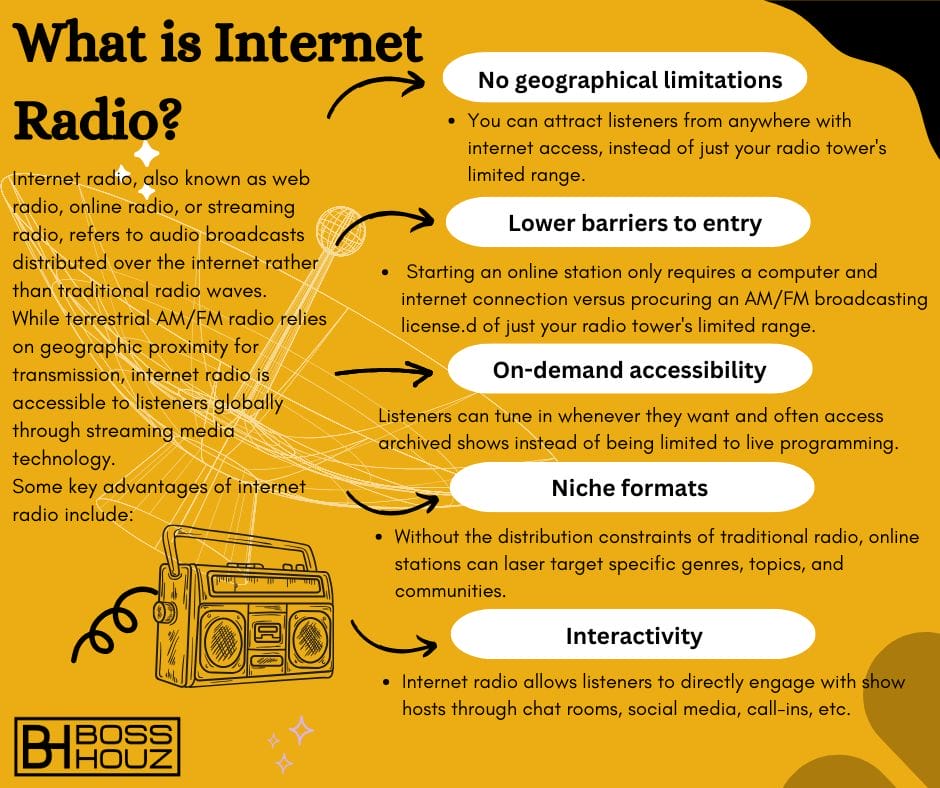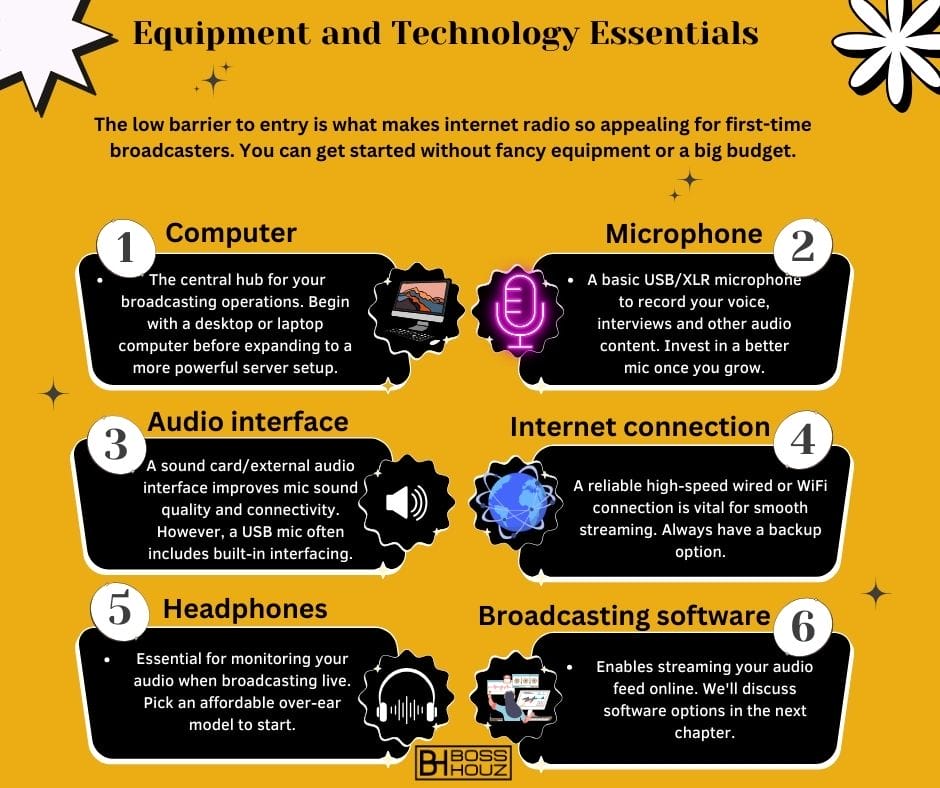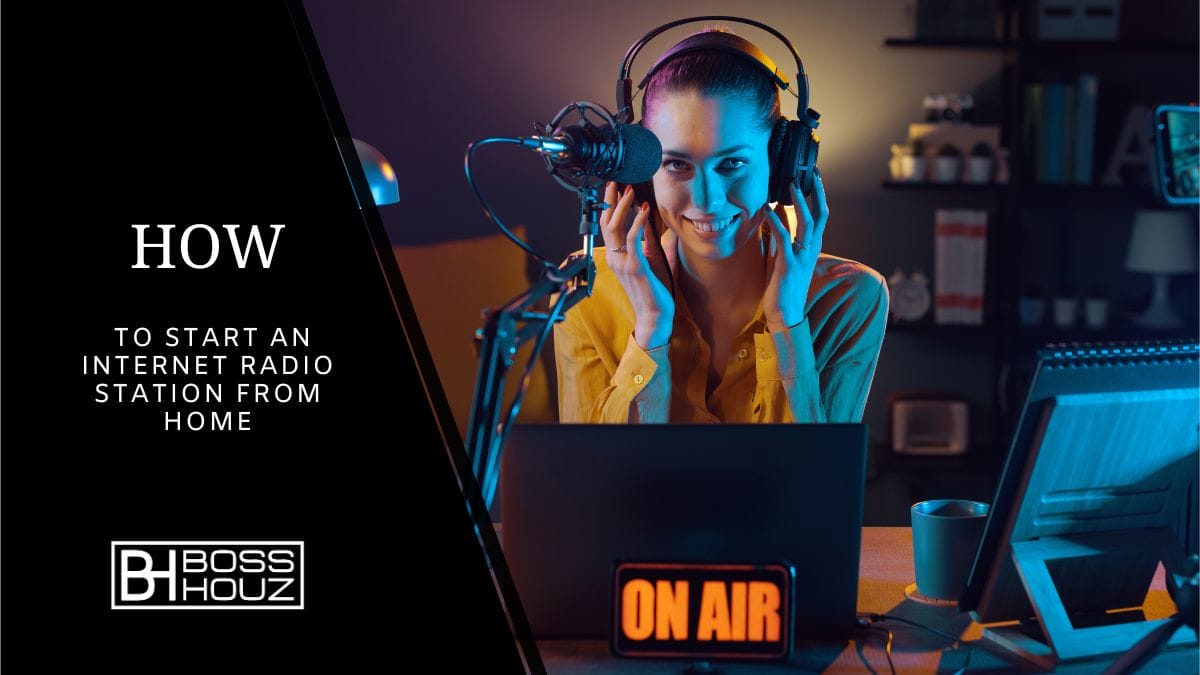Starting an internet radio station from home is easier and more accessible than ever. With the rise of online broadcasting, anyone with a computer, microphone, and internet connection can share their voice with the world.
In this comprehensive guide, we’ll walk you through every step of the process, from conceptualizing your station to growing your listenership. You’ll learn insider tips on legal considerations, technical setup, marketing tactics, and monetization models to turn your online radio dreams into a rewarding reality.
Whether you want to play DJ, host talk shows, or give your local community a platform to connect, internet radio provides immense creative potential.
By the end, you’ll have the confidence and knowledge to start broadcasting your unique brand of audio content right from your living room. Let’s begin this exciting journey!
Table of Contents
Looking to Start an Internet Radio Station?
The internet has opened a sea of opportunities for broadcasting niche content to engaged audiences globally.
Unlike traditional terrestrial radio’s geographical constraints, online radio gives you the freedom to attract listeners from anywhere with an internet connection.
As per Digital Music News:
- The global online radio market is projected to reach a value of $10.9 billion by 2028, growing at an impressive CAGR of 15.4%.
- In the US, internet radio accounts for 11.6% of all audio listening. This share is steadily rising as people embrace the flexibility of on-demand content.
- There are already over 60,000 active internet radio stations worldwide, with independent broadcasters making up a sizable portion.
- The total monthly audience for internet radio is estimated to be over 100 million active listeners globally.
With such a massive addressable market, the possibilities are endless. All you need is passion for your subject matter, diligence to set up your station properly, and persistence to grow your listenership.
Let’s explore how to capitalize on this opportunity and start an internet radio station right from the comfort of your home.
“The future of radio is here. It lives online.” – James Cridland, Radio Futurologist
Chapter 1: Understanding Internet Radio
Before diving into the details of launching your own online radio station, let’s first understand what internet radio is and why listeners are tuning in.
1.1 What is Internet Radio?


Internet radio, also known as web radio, online radio, or streaming radio, refers to audio broadcasts distributed over the internet rather than traditional radio waves.
While terrestrial AM/FM radio relies on geographic proximity for transmission, internet radio is accessible to listeners globally through streaming media technology.
Some key advantages of internet radio include:
- No geographical limitations – You can attract listeners from anywhere with internet access, instead of just your radio tower’s limited range.
- Lower barriers to entry – Starting an online station only requires a computer and internet connection versus procuring an AM/FM broadcasting license.
- On-demand accessibility – Listeners can tune in whenever they want and often access archived shows instead of being limited to live programming.
- Niche formats – Without the distribution constraints of traditional radio, online stations can laser target specific genres, topics, and communities.
- Interactivity – Internet radio allows listeners to directly engage with show hosts through chat rooms, social media, call-ins, etc.
While internet and terrestrial radio share similarities in entertainment through audio content, their technical delivery, business models, and programming approaches differ significantly. Online radio removes many of traditional radio’s pain points for both broadcasters and listeners.
1.2 The Rise of Internet Radio Listening
Internet radio may have started as an experimental novelty in the early 2000s but has since become a mainstream audio medium.
Here are some statistics that showcase the impressive growth:
- According to Edison Research, the percentage of Americans 12+ who have listened to online radio in the last month has risen from 9% in 2002 to 75% in 2021.
- Internet radio now accounts for 11.6% of all audio listening in the U.S. This number grows to 23% among adults 25-54.
- 60% of Americans report listening to online radio on a smartphone and 40% in the car via Bluetooth connectivity.
- The monthly online radio audience grew to 156 million in the U.S. and 318 million globally in 2020, as perRAIN News.
- During COVID-19 lockdowns, online radio saw a 16% increase in listenership as people spent more time indoors.
The trend is clear – internet radio is gaining momentum both as a platform for niche broadcasts and for distributing popular terrestrial shows online.
There has never been a better time to start an online radio station catering to underserved interests and communities. Where traditional radio may struggle, internet radio picks up the mantle thanks to its versatility and expansive reach.
“We are witnessing an audio revolution that will only continue to grow. Now is the time to find your unique voice.” – Ben Manilla, Co-Founder, Podcast Movement
Chapter 2: Planning Your Internet Radio Station
Having understood the appeal of internet radio, let’s start planning the launch of your own online station. We will cover key steps like identifying your audience, considering legalities, and buying equipment.
2.1 Defining Your Concept and Audience
The first step is to conceptualize the purpose and niche of your internet radio station.
Ask yourself the following questions:
- What formats interest me – talk radio, music radio, sports, news, etc?
- What specific genres or topics do I want to focus on?
- Who is my target demographic and what do they care about?
- How will my station be unique and fill a gap in the market?
- Do I want localized content or a broader international audience?
Your station concept should flow from your own passions and interests. Running an internet radio station is rewarding but also requires significant time. Picking a niche you genuinely care about will keep you motivated.
It also helps to identify an underserved audience looking for audio content related to your niche. For instance, if you love post-rock ambient music, dig into online communities to see if other listeners share your enthusiasm.
By zeroing in on a specific target demographic, you can craft programming and marketing tailored to their needs, building a loyal following over time.
“Keep your internet radio format hyper-focused. Don’t cast too wide a net in trying to attract every listener.” – Ben Waggoner, Author, The Radio Station Owner’s Handbook
2.2 Music Licensing and Legal Considerations
While internet radio allows more creative freedom, you still need to follow regulations, especially regarding copyrighted content.
Here are some key legal aspects to consider:
- If your station plays commercial music, you must obtain public performance licensing from organizations like ASCAP, BMI, SESAC and SoundExchange. Royalty costs vary based on factors like audience size.
- You may need additional sync licensing if you remix or alter songs. Using exclusively creative commons/royalty-free music avoids this.
- Interviews, guest audio clips etc. typically require a signed release form to broadcast.
- Comply with FCC regulations like not airing indecent/profane content or making false claims.
- Terms of service often prohibit re-broadcasting live streamed content from other sources like TV networks.
- Follow additional country-specific broadcasting laws if expanding your listenership globally.
Consult a qualified attorney to understand the licensing requirements for your programming format and locale. While royalties can add up, this enables you to use copyrighted content legally. Alternatively, public domain content and direct artist partnerships are how internet radio stations often work around licensing costs.
Getting things right early on protects you down the road as your listenership grows. Leave no legal stone unturned before launch.
2.3 Equipment and Technology Essentials


The low barrier to entry is what makes internet radio so appealing for first-time broadcasters. You can get started without fancy equipment or a big budget.
Here are the basic technical components:
- Computer – The central hub for your broadcasting operations. Begin with a desktop or laptop computer before expanding to a more powerful server setup.
- Microphone– A basic USB/XLR microphone to record your voice, interviews and other audio content. Invest in a better mic once you grow.
- Audio interface – A sound card/external audio interface improves mic sound quality and connectivity. However, a USB mic often includes built-in interfacing.
- Internet connection – A reliable high-speed wired or WiFi connection is vital for smooth streaming. Always have a backup option.
- Headphones – Essential for monitoring your audio when broadcasting live. Pick an affordable over-ear model to start.
- Broadcasting software – Enables streaming your audio feed online. We’ll discuss software options in the next chapter.
You can start your station for a modest upfront investment of $200-$500 for this basic equipment. As your audience expands, upgrade to higher quality gear over time.
For now, focus on the essentials to get your station live. The beauty of internet radio lies in its simplicity – all you need is a mic, computer, and passion to share your voice.
“I started my online radio show using just my laptop and a $60 microphone. You don’t need fancy equipment to begin broadcasting your passion.” – Sarah B., Founder of DIY Crafts Radio
Chapter 3: Setting Up Your Internet Radio Station
You’ve got your station concept, tech gear, and understand the legal landscape. Now it’s time to tackle the practical setup to get your online station broadcasting.
3.1 Choosing the Right Broadcasting Software
One of the most important choices is your internet radio broadcasting software. This powers taking your live or pre-recorded audio and streaming it online for listeners.
Some top options to consider include:
- Icecast – Open source software ideal for independent broadcasters. Provides Server/Client architecture.
- ** BUTT** – Free streamer focused on simplicity. Easy to install and configure. Works with Icecast.
- Mixxx – Full featured free DJ software with integrated streaming support.
- Zara Radio – Cloud-based Automation and Scheduling software starting at $19/month. Integrates with Icecast.
- Live365 – Paid turnkey hosting and broadcasting service starting at $19.95/month. Better for beginners.
- StreamOn – Full broadcast studio suite from $29/month designed for musicians and radio pros.
Depending on your technical proficiency, consider open source options like Icecast and BUTT for greater customization freedom or paid services like Live365 for an easier pre-configured setup. Most also offer trial periods to test which fits your use case best.
Pro Tip: Look for SHOUTcast compatibility to enable directory listings and wider exposure.
3.2 Finding a Reliable Hosting Provider
To make your radio stream available online 24/7 you will need reliable radio hosting services.
Again you have both DIY and fully managed options:
- General web hosts like Bluehost, HostGator, etc. provide the servers but require you to handle the technical configuration. Cost starts around $3-10/month.
- Specialized internet radio hosts like Icecast VPS, Cloudrad.io, Radionomy, etc. take care of the setup and DevOps. Prices from $10-50/month.
- End-to-end services like Live365 include hosting and come with easy web apps to manage scheduling, playlists, etc. Plans from $19.95/month.
Look for providers with redundancy protection, traffic volume allowances, and 99%+ uptime guarantees. While shared hosting works when starting out, consider a dedicated server or virtual private server as your listenership scales up.
Find a hosting provider that truly understands the nuances of delivering reliable and scalable radio streaming services. This expertise is worth paying more for.” – Mark R., Founder of RadioHosting.co
3.3 Designing Your Station Format and Schedule
With your tech stack decided, it’s time to map out your station’s programming format and schedule:
- Will your station be all talk, all music or a mix? Consider the ratio between host segments vs. playlist songs.
- Decide on a consistent structure for your shows, including opening/closing hooks and segment runtimes.
- Schedule any recurring programs like morning shows, drive time, studio sessions etc.
- Build in time for interviews, call-ins, contests, guest segments and other special features.
- Leave gaps for news/traffic updates if relevant to your niche. Promos and ads also fit nicely into breaks.
- Alternate high energy segments with slower paced ones to vary rhythm and maintain engagement.
- Use clock format for show times, e.g. 8:00 am rather than “next up.” Helps listening on-demand.
While allowing flexibility for the organic nature of radio, having a solid roadmap ensures professionalism and keeps your station running smoothly.
Aim for thematic consistency while offering enough diversity to sustain interest. Your schedule should reflect the core format while providing depth. Treat it as an evolving framework as you find your groove.


Chapter 4: Creating Compelling Content
With your tech stack ready, the real work begins – producing captivating shows and audio content to engage listeners.
4.1 Curating Music and Creating Playlists
For music-focused stations, carefully curating your song selection is key. Follow these best practices when building playlists:
- Pick tracks that flow together across tempo, mood, genres etc. Don’t just use shuffle mode.
- Find the balance between familiar hits and deep cuts & new releases – about 70/30 works well.
- Keep diversity in mind when featuring different artists, eras, and styles. But maintain cohesion.
- Have a healthy ratio of vocal vs. instrumental tracks based on your station’s vibe.
- Use scheduling software to slot in song titles, artist info, purchase links etc.
- Consider having a daily “picks of the week” segment to highlight new releases and bubbling acts.
- Enable request lines and monitor chat comments to incorporate listener preferences.
- Promote emerging local artists to give your regional scene exposure. Offer open mic nights.
Curate music not just randomly but almost as you would sequence the chapters of a great book – take listeners on a journey. This bredth and pacing builds an emotional connection beyond the standalone appeal of any one track.
4.2 Developing Talk Shows and Podcasts
For talk radio stations, you’ll need to develop engaging segments and podcasts. Here are some tips:
- Prepare talking points but have a natural conversation flow versus sounding too scripted.
- Pull in special co-hosts and guests like authors, creators, or experts relevant to your topic.
- Conduct pre-interviews with guests to identify interesting insights to highlight.
- Use call-screens/call-ins to incorporate real listener voices.
- Edit pre-recorded interviews to polish flow for re-airing.
- Invest in dynamic mics like Shure SM7B when conduncting studio interviews.
- Feature commentary around current events related to your niche.
- Sprinkle in lighter short-form segments like listener polls and pop culture hot takes to add variety.
- Develop recurring segments like “Man on the Street” vox pop interviews, special Q&As, industry insider commentary etc.
“Internet radio gives you creative license. Have fun brainstorming segment ideas you’d never hear on mainstream radio. Let your personality shine through.” – Sarah Lane, Podcaster & Internet Radio Host
Great shows strike the balance between polish and authenticity. Avoid feeling overly rehearsed but also guide conversation with purpose and direction. Utilize your niche knowledge to engage both expert guests and everyday listeners alike.
The most memorable segments often come from spontaneous moments. Be prepared but also follow your curiosity in the flow of the conversation.
Chapter 5: Growing Your Audience
You put in the hard work setting up your station and creating quality programming. But without listeners, it is just noise on the internet. Now we examine proven tactics to build an audience.
5.1 Marketing Strategies for Your Radio Station
Promoting your station is a continuous effort, not a one-time campaign. Take a multifaceted approach:
- Leverage social media with dedicated accounts for your station and shows. Share audio clips and promotional graphics.
- Claim and optimize free directory listings on services like TuneIn, iHeartRadio, Radio Garden etc.
- Run contests and giveaways to incentivize sharing and attract new listeners through virality. Offer merch as prizes.
- Partner with complementary brands/podcasts/stations for cross-promotion opportunities, guest swaps, and community building.
- Purchase targeted online ads focused on your core demographic’s interests. Test platforms like Facebook, Instagram, Google, Reddit, etc.
- Submit press releases to radio/music publications profiling your station’s launch and mission. Pitch targeted podcast reviewers.
- Analyze data like streaming metrics, download stats, and listener surveys to refine your marketing and programming.
By making promotion a habit rather than one-off push, you reinforce your station’s brand steadily. Remember, quality and consistency keeps audiences engaged long-term.
5.2 Leveraging Social Media for Growth
Due to its shareability, internet radio lends itself extremely well to social media marketing:
- Facebook – Share preview clips and station updates. Facebook groups are great for community building.
- Twitter – Embed tweets with audio clips. Use relevant hashtags. Tag featured artists/guests.
- Instagram – Post studio setup photos, behind the scenes, host announcements etc.
- YouTube – Upload video versions of segments and interviews. Add timestamps and links back to full shows.
- TikTok – Partner with influencers to remix clips into short videos. Or make station-specific audio/visual content.
- Reddit – Share your content in relevant Subreddits. Offer AMAs and contests for engagement.
- LinkedIn – Attract industry guests by showcasing station achievements and press features.
The visual nature of platforms like Instagram and YouTube gives fans a peek behind the scenes, while communities like Reddit allow active discussions around your shows
Absolutely, here is the continuation:
5.3 Engaging with Listeners and Building Community
Beyond just attracting listeners, you need to actively engage them and foster a sense of community:
- Make listeners co-collaborators – Solicit topics, feature fan-submitted content, and recognize your “super fans.”
- Highlight user-generated content like fanart, playlists, discussions etc. This makes fans feel invested.
- Respond to comments and messages – Don’t just post and forget. Reciprocate the relationship.
- Send email newsletters with station updates, events, merch deals etc. Nurture off-platform relationships.
- Organize local meetups or events – Meet listeners IRL once comfortable. Could even record live shows.
- Consider patronage/membership options – Benefits like ad-free listening, exclusive content etc. reward loyal community members.
“The most successful internet radio stations view listeners not as just an audience, but an integral part of the experience.” – Neil Patel, Digital Marketer & Blogger
By valuing contributions from fans, they evolve into partners on your station’s journey instead of passive observers. An engaged community ensures long-term viability.
Chapter 6: Monetizing Your Internet Radio Station
For long-term sustainability, you will likely need to monetize your online radio station. Thankfully, you have options beyond just ads.
6.1 Exploring Revenue Models for Internet Radio
Common strategies to monetize include:
- Advertising – Sell audio/display ads programmatically or directly to brands relevant to your audience. Rates vary based on listenership size and niche.
- Paid subscriptions – Offer ad-free listening, exclusive content etc. for a monthly fee. Allows predictable recurring revenue.
- Commissions/affiliates – Earn revenue by promoting products/services used by your niche listeners. Ensure transparency.
- Paid content – Produce premium content, courses, workshops etc. that fans pay for. Leverage your expertise.
- Donations – Crowdfunding through platforms like Patreon for recurring donations from dedicated fans.
- Live events – Ticket sales from hosting local events, concerts, conferences etc. Merch sales at these.
- Cross-media – Repurpose audio content into YouTube videos, podcasts, books etc. to diversify revenue streams.
For larger stations with professional studios and hosts, advertising remains the primary income source. But for independent stations, fan funding and premium content offer better alignment.
Experiment to see which monetization models fit organically without compromising your creative vision or community trust. Transparency is key.
6.2 Attracting Advertisers and Sponsorships
If you do want to monetize through audio ads, keep this in mind:
- Produce an information kit outlining audience demographics, reach, content formats etc. to help secure ad deals.
- Offer options like host-read spots, pre-produced spots, event sponsorships etc. based on budget.
- Start with relevant niche brands already aligned with your audience’s interests.
- Set pricing tiers based on listener numbers, ad length/placement and level of personal endorsement.
- Limit ad density to max 3 mins/hour to avoid excessive interruptions.
- Clearly segment ad slots from regular programming using station imaging/jingles.
- Help craft tie-ins and endorsements that flow naturally instead of abrupt hard sells.
“For internet radio, a small but hyper-targeted listenership that trusts your brand recommendation is worth far more than a passive mass audience.” – Chad H., Independent Station Owner
Quality over quantity applies to both your programming and advertisers. Be selective about who you allow on your airwaves in service of your audience experience.
Chapter 7: Maintaining and Expanding Your Station
Congratulations on getting your internet radio station up and running! But the real work begins now – keeping your content and operations running smoothly.
7.1 Keeping Content Fresh and Engaging
Some tips to avoid going stale:
- Frequently rotate in new segments and features. Retire old ones that lack excitement.
- Take listener requests and feedback regularly to adapt to their evolving tastes.
- Vary co-hosts to benefit from diverse personalities and banter styles.
- Attend industry/community events for inspiration on new topics and trends to cover.
- Travel for outside broadcasts like concerts and conferences related to your niche.
- Follow emerging artists/releases in the music scene you support. Help fans discover what’s next.
- Take periodic breaks to recharge creativity and come back energized. Stockpile evergreen content to air during.
The core of your programming should remain aligned with your original concept. But challenge yourself to keep it fresh within that framework.
7.2 Technical Maintenance and Support
Behind the scenes upkeep is crucial as well:
- Monitor audio levels, streaming stats, download errors etc. and troubleshoot issues immediately.
- Keep software updated and refresh hosting infrastructure before usage outpaces capacity.
- Back up audio files and data regularly to avoid losing content. Consider offsite backups.
- Clean and inspect equipment like mics on a consistent basis. Make repairs and upgrade gear when needed.
- Automate recurring tasks like playlist updates where possible to focus your efforts on unique content.
- Hire freelance mods to screen chat comments and help with community management as you scale.
Your tech stack will require constant fine-tuning. But dedicating time to stability and scalability now avoids headaches down the road.
7.3 Expanding Your Reach with Advanced Techniques
Once you’ve nailed the basics, explore opportunities like:
- Multi-platform distribution – Also air your programming through services like iHeartRadio, TuneIn, apps etc. to widen reach.
- International expansion – If ready for the complexity, obtain additional streaming licenses to tap new demographics.
- Simulcasting – Stream both online and over FM using LPAM/LPFM licenses for local coverage.
- Visual media – Grow your brand with YouTube, TikTok etc. Add in video versions of segments where possible.
- Podcasting – Repackage key segments as on-demand podcast episodes to find new audiences.
- Smart audio – Implement voice tech features on smart speakers and in-car to expand listening scenarios.
- Networking – For talk radio, syndicate your top shows via other stations both terrestrial and online to gain new fans well beyond your home market.
Sustaining a thriving station is a journey of constant evolution. Embrace opportunities to diversify your distribution and content formats without straying too far from your core mission.
“Internet radio removes the shackles of convention. Stay creatively restless!” – Mark Ramsey, Media Strategist


Chapter 8: Success Stories and Inspirations
By now you understand the work involved in running an internet radio station. But also keep sight of the immense rewards if you stick with it.
Let’s look at real-world examples of independent broadcasters who turned their passion into profitable online radio businesses and thriving communities.
8.1 Case Studies of Successful Home-Based Stations
- BFF.fm – Launched in 2004 by High School friends in Pittsburgh, it gained fame for its eclectic mix of underground and local indie music. Now with studios in LA, it is one of the biggest independent internet stations worldwide.
- Radio Milwaukee – From humble origins broadcasting out of founder Jordan Lee’s kitchen in 2007, it has grown into a staple for the Milwaukee music scene with 11 full-time staffers.
- KDHX – Volunteer-run community station in St. Louis operating since 1987. With a massive local music library, their slogan “Live from St. Louis, it’s your radio station” reflects their communal approach.
- WFMU – This iconoclastic freeform station based in Jersey City has nurtured countless indie musicians and DJ personalities with its radically varied programming since 1958.
These stories reveal how a hyper-local focus and lean startup mentality can grow into something with global reach. Your station’s legacy starts with that very first broadcast.
8.2 Interviews with Industry Leaders
“I encourage you to embrace this opportunity. Your fresh voice will find eager listeners who share your passion and interests, no matter how niche. The internet radio community is so supportive of new stations and I can’t wait to welcome you!” – Hilary Saunders, News Editor at Radio.com
“Starting an internet radio station doesn’t require deep pockets or professional credentials. You already have everything it takes. As long as you persevere and care deeply about serving your listeners, you will make your mark.” – Gerald Seligman, Executive Director, Bay Area Radio Museum
Hopefully these stories and encouraging words from radio veterans assuage any doubts. Your vision aligned with the effort will be rewarded. Now get out there and start broadcasting!
Conclusion
We’ve covered all the steps needed to start your own internet radio station – from initial planning and technical setup to creating compelling content and growing your listenership.
While not without challenges, the opportunities far outweigh any roadblocks for determined broadcasters. The barrier to entry is low but the creative potential is massive.
Internet radio allows you to build intimate connections with niche communities globally. In many ways, these small-scale passion projects represent the future of the medium.
So take that first step. Discover your on-air voice. Persist through early days without an audience. Build your skills and technical know-how. Collaborate with kindred spirits. Stay relentlessly curious.
Once you embraced the process, momentum follows. Before you know it, you’ll have a thriving station and community eager to hear what you have to say.
Believe in your unique vision and serve your listeners with consistency. The rest will follow. Wishing you the best of luck on this exciting journey! The airwaves are waiting for your authentic voice. Start broadcasting.








